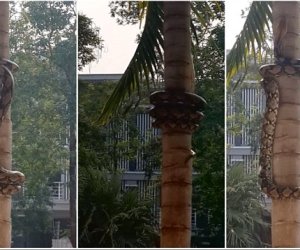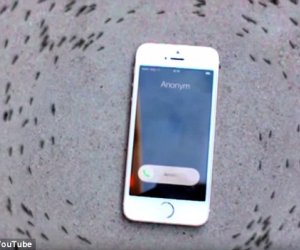Can you control ANTS with your iPhone?

A video showing ants apparently responding to a ringing iPhone by forming a spiralling circle around the device has baffled viewers.
The insects seem to form a distinct ring around the smartphone as it begins to vibrate on the ground, leading to claims it is somehow altering their behaviour.
While the video may be a hoax, there are examples from nature of ants responding in this way to threats or in response to food.
Known as an ant mill, colonies of insects can get stuck in an endless loop as each ant follows the trail of pheromones laid down by the one in front of it.
Ants usually use these pheromones as chemical signals to help other members of the colony find their way to sources of food or as emergency beacons when defending a colony.
In the new video, the ants appear to form the circle only once the iPhone starts to receive a call.
It has led to claims that the vibrating phone may trigger a pheromone response and there are some theories that the electromagnetic radiation may be changing their behaviour.
According to biologist Simon Robson, a social insect expert at James Cook University in Queensland, Australia, who was speaking to the news website BoingBoing: 'The shape of the phone may have something to do with it and the vibration might get them a bit more excited.'
However, there are some who believe the video is a complete fake, pointing to what appears to be poorly made CGI footage of the ants.
Some comments posted on YouTube have pointed out that the ants themselves appear to move through each other as if they are digitally rendered.
Others have pointed to the strange behaviour of the phone itself as a sign that something is amiss – the screen appears to show a video of the surrounds that stays in place even when the phone rings.
This, of course, could simply be a reflection of the surrounding on the iPhone's screen but some have said it appears to be backlit as when the call comes in, it does not disappear.
Previous research, however, has claimed that mobile phones can influence the behaviour of ants.
Dr Marie-Claire Cammaerts-Tricot, an ecologist at the Free University of Brussels, has conducted tests of ants in the laboratory to see how they respond to electromagnetic radiation from mobile phones.
She claims that the radiation appeared to influence their ability to be 'trained' and also seemed to effect the way they move.
However, other experts have criticised her work, saying the changes in behaviour in the ants were not statistically significant and could have occurred at random.
If the video is real, it could simply be a response to the vibration of the phone itself and may help to shed light on why ant mills form.
Researchers have said in the past the apparent paradox of such behaviour occurring, which often results in the death of a colony, may simply be the price they pay for their ability to work together.
Dr Iain Couzin, an evolutionary biologist at Princeton University who has studied army ant mills, said they were often triggered after rainstorms in the wild.
He said: 'Army ants are not only good at following trails but also have a propensity to form circular mills when moderate numbers are separated from a colony and restricted to a confined area, either in the laboratory or naturally in the field during exceptionally severe rainstorms.
'After a period of disorder, the ants all begin moving in the same direction. This behaviour is likely to reflect the ability of army ant colonies collectively to select a raid direction.'
(Daily Mail)
www.ann.az
Similar news
Similar news
Latest news 
More news 



































 Photo
Photo 



 Video
Video 

